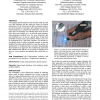Free Online Productivity Tools
i2Speak
i2Symbol
i2OCR
iTex2Img
iWeb2Print
iWeb2Shot
i2Type
iPdf2Split
iPdf2Merge
i2Bopomofo
i2Arabic
i2Style
i2Image
i2PDF
iLatex2Rtf
Sci2ools
UIST
2006
ACM
2006
ACM
Pen-top feedback for paper-based interfaces
Current paper-based interfaces such as PapierCraft, provide very little feedback and this limits the scope of possible interactions. So far, there has been little systematic exploration of the structure, constraints, and contingencies of feedback-mechanisms in paper-based interaction systems for paper-only environments. We identify three levels of feedback: discovery feedback (e.g., to aid with menu learning), status-indication feedback (e.g., for error detection), and task feedback (e.g., to aid in a search task). Using three modalities (visual, tactile, and auditory) which can be easily implemented on a pen-sized computer, we introduce a conceptual matrix to guide systematic research on pen-top feedback for paper-based interfaces. Using this matrix, we implemented a multimodal pen prototype demonstrating the potential of our approach. We conducted an experiment that confirmed the efficacy of our design in helping users discover a new interface and identify and correct their errors. ...
| Added | 14 Jun 2010 |
| Updated | 14 Jun 2010 |
| Type | Conference |
| Year | 2006 |
| Where | UIST |
| Authors | Chunyuan Liao, François Guimbretière, Corinna E. Löckenhoff |
Comments (0)

